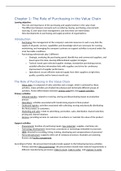Chapter 1: The Role of Purchasing in the Value Chain
Leaning objective:
- The role and importance of the purchasing and supply function in the value chain
- The difference between concepts such as ordering, buying, purchasing, procurement,
sourcing, SC and value chain management, and how these are interrelated.
- New developments in purchasing and supply practices of organizations.
Introduction
- Purchasing: the management of the company’s external resources in such a way that the
supply of all goods, services, capabilities and knowledge which are necessary for running,
maintaining, and managing the company’s primary an support activities is secured under the
most favorable conditions.
- Purchasing professionals play 3 different
o Strategic: analyzing the purchasing spend, identify key and commercial suppliers, and
based upon this data, develop differentiated supplier strategies
o Tactical: based upon selected supplier strategy, standardize purchasing process,
establish effective information links with suppliers and strive for continuous
improvement of supplier performance
o Operational: secure efficient material supply from their suppliers at right time,
quality, quantity and for lowest overall cost.
The Role of Purchasing in the Value Chain
- Value chain: is composed of value activities and a margin, which is achieved by these
activities. Value activities are divided into physical and technically different groups of
activities. Porter differentiates between primary activities and support activities.
Primary activities
- Inbound logistics: related to receiving, storing and disseminating inputs to production
process
- Operations: activities associated with transforming inputs int final product
- Outbound logistics: activities associated with collecting, storing and physically distributing
the final product to customers.
- Marketing and sales: relate to advertising, promotion, sales, distribution channel selection,
pricing and channel relations
- Services: providing services to customers to enhance or maintain the value of the product
Support activities
- Procurement: function of purchasing inputs (raw materials), supplies, machinery etc.
- Technology development: know-how, procedures or technology embodied in processes
- HRM: directed to recruiting, hiring, training, developing and compensations of personnel
- Firms infrastructure: supports entire set of company processes. Examples are planning,
finance and facility management.
According to Porter, the procurement should provide support to the following business activities:
- Primary activities (direct purchasing): the procurement should meet material requirements is
different manufacturing processes; Make to stock, make to order, and engineer to order.






